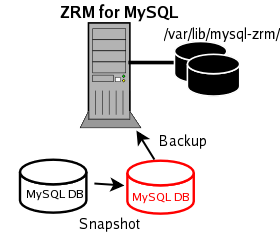Table of contents
MySQL Configuration
- Both the ZRM server and MySQL server require the configuration of sudo privileges (see the next section). On Solaris platforms, this means the SMCsudo package must be installed.
- If you are backing up a remote MySQL server, the destination directory specified on the Backup Where page must exist on the MySQL server as well as the ZRM server. The MySQL backup user (OS-level) must have read/write permission to access this directory.
The mysql data must reside on logical volumes. The following are some of the possible configurations
- All MySQL data is on a single logical volume
- Specific database directories are on different logical volumes
- For databases containing InnoDB based tables, the lvm snapshot can only be used if the database directory, the InnoDB data files, and the InnoDB logs are on logical volumes.
- The InnoDB shared data files are on a separate logical volume
- The InnoDB logs are on a separate logical volume

Pre-conditions for Using LVM Snapshots
- The MySQL backup user must be granted sudo privileges to execute lvm commands on the MySQL server. Add a line similar to the following example to /etc/sudoers on the MySQL server:
mysql ZRMserver.mycompany.com Server>=NOPASSWD:/bin/mount,NOPASSWD:/bin/umount,NOPASSWD:/bin/df, \
NOPASSWD:/sbin/lvdisplay,NOPASSWD:/sbin/lvcreate,NOPASSWD:/sbin/lvremove
- where ZRMserver.mycompany.com is the fully-qualified domain name for the ZRM server. Note that if lvm commands are installed in non-standard locations, the above example would not work without editing it to reflect the different paths.
- Additional free extents in the logical volume are needed for creating snapshots.
- This can be checked with 'vgdisplay' command.
- The free extents required are specified in mysql-zrm.conf.
- Note that during the process of creating the backups the disk space may fall short.
- LVM stores the snapshot blocks corresponding to the blocks that are modified in the original logical volume in the snapshot volume.
- If the database is highly active during the backup, many blocks will be modified and snapshot volume may run out of space.
- Specifying the right amount of space for creating the snapshot is critical; if the snapshot volume runs out of space, the backup will not be consistent.
- All MySQL database files (data, log, indexes) must be stored in LVM logical volumes to ensure consistency.
- If any of the files are not on LVM, the snapshot is skipped, and either a raw backup via mysqlhotcopy or a logical backup using mysqldump will be taken based on the storage engines of the tables in each of the databases.
